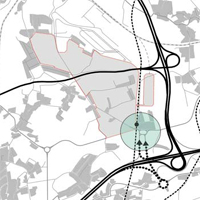The Leixões Logistics Platform, Portugal, and its Territory
Abstract
Within the global scenario, where the production has been fragmented in very distant locations, the attention has been placed on logistics and intermodality. The increasing flow of goods needs, indeed, a more efficient and effective logistics system, which requires logistics platforms located in strategic areas. These platforms, nevertheless, produce negative impacts on the areas where they are settled. Within this context, the present paper aims at critically analyzing the preliminary plan of the Leixões logistics platform, specifically the Gatões Guifões logistics node, in the Porto metropolitan area, in order to investigate how the following issues have been tackled: mobility, the relationship of the area with the patterns of the location system, the relationships with the environmental protection zones bordering the southern part of the logistics node. On the basis of this close scrutiny, some planning hypotheses have been put forward. These hypotheses aim to modify some patterns of the planning settlement layout, leaving the overall layout as it is. The Gatões Guifões logistics node represents an interesting case study because it is located in an area hosting scattered and medium sized settlements, which are typical of the “urbanized countryside”, with a dense network of different routes and with environmental protection areas. This paper underlines that the logistics platforms’ topic can/may become a planning, urban design and architecture topic. The logistics platforms are “mega-facilities” with functional peculiarities, which generate negative effects (social, economic, environmental) on the territory. The mitigation of such negative externalities, and the related compensation measures might be studied by the territorial scientists, the planners and become a relevant subject for the policy makers, too. Specifically, the so-called “sustainable integration” of the logistics structures is a topic involving both architectural and urban design expertise. The paper is structured into five sections. The introduction is followed by a short description of the logistics system in Portugal and of the National Logistics Plan. Section 3 is dedicated to the description of the Leixões platform preliminary project and Section 4 focuses on the critical analysis of such a project and on the planning alternatives. Conclusions follow.Downloads
References
Boscacci F. (2003) (a cura di) La nuova logistica. Una industria in formazione tra territorio, ambiente e sistema economico, EGEA, Milano.
Carvalho S. (2006) Portugal Logistico, A. T. Kearney, Lisboa.
Commissione Europea (2001) Libro Bianco: “La politica europea dei trasporti fino al 2010”, Bruxelles.
Domingues A. (2009) Megastructures. What is really the point?”, Territorio, n. 48, pp. 21-27.
ECMT (1996) Polarisation of European logistical areas and new trends in logistics. ECMT, Paris.
Elia S., Maggi E., Mariotti I. (2009) “Gli effetti dell’internazionalizzazione produttiva sulla domanda di lavoratori delle imprese logistiche nelle regioni italiane”, in Borruso G., Forte E., Musso E., a cura di, Economia dei trasporti e Logistica economica: ricerca per ‘innovazione e politiche di governance, Giordano Editore, Napoli, pp. 571-594.
Ferreira da Silva L.P. (2002) “Porto: un esempio di città diffusa”, in Cuomo A., Szaniszlò G. (a cura di), L’identità plurale, Guida, Napoli.
Maggi E., Mariotti I., Boscacci F. (2008) “The indirect effects of manufacturing internationalisation on logistics. A focus on the industrial districts of Veneto”, International Journal of Logistics Economics and Globalisation, Vol. 1, No. 2, pp. 205-224.
Morandi, Pucci P., Rolando (2009) (a cura di) “Megastrutture a grande occupazione di suolo e dinamiche territoriali. Casi europei a confronto”, Territorio, n. 48, pp. 7-61.
Rolando A. (2009) “Sperimentazioni progettuali per piattaforme complesse: spunti per una discussione”, Territorio, n. 48, pp. 51-55. Virano A. (2009) “Novaring: un modello innovativo per le aree dei servizi sui corridoi plurimodali”, pp. 56-59. Tiry C. (2008) Les mégastructures du transport. Typologie architecturale et urbaine des grands équipements de la mobilité, CERTU.

Copyright (c) 2014 Tema. Journal of Land Use, Mobility and Environment

This work is licensed under a Creative Commons Attribution 4.0 International License.
Authors who publish in this journal agree to the following:
1. Authors retain the rights to their work and give in to the journal the right of first publication of the work simultaneously licensed under a Creative Commons License - Attribution that allows others to share the work indicating the authorship and the initial publication in this journal.
2. Authors can adhere to other agreements of non-exclusive license for the distribution of the published version of the work (ex. To deposit it in an institutional repository or to publish it in a monography), provided to indicate that the document was first published in this journal.
3. Authors can distribute their work online (ex. In institutional repositories or in their website) prior to and during the submission process, as it can lead to productive exchanges and it can increase the quotations of the published work (See The Effect of Open Access)
